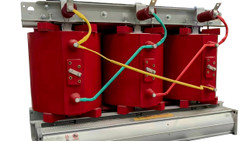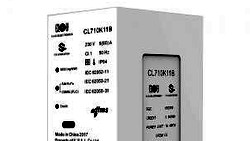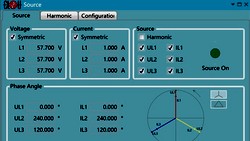HVDC (High-Voltage Direct Current) transmission is a method of transmitting electrical power over long distances using high-voltage direct current instead of alternating current. This approach offers several advantages over traditional AC transmission, such as reduced line losses, increased transmission capacity, and the ability to interconnect power systems and integrate renewable energy sources.
In this overview, we will look into the fundamental aspects of HVDC transmission, including its definition, a comparison with AC transmission, and an explanation of its working principle. Additionally, we will explore the key components involved in HVDC transmission, the conversion process from AC to DC and vice versa, and the roles of converters and transformers in facilitating efficient power transmission.
The Basics of HVDC Transmission
HVDC transmission is a technology that enables the efficient transmission of electrical power over long distances by utilizing direct current instead of alternating current. Unlike AC transmission, which relies on constantly changing voltage and current, HVDC systems maintain a constant voltage and direction of current flow. This characteristic allows for lower line losses, improved power quality, and increased transmission capacity, making HVDC an attractive option for long-distance power transmission.
In contrast to AC transmission, which is widely used for short and medium-distance power transmission, HVDC transmission offers several distinct advantages. AC transmission requires complex and costly infrastructure, such as multiple conductors and substations, to handle the challenges of long-distance transmission due to high line losses and reactive power issues. HVDC transmission, on the other hand, mitigates these challenges by maintaining a constant voltage and minimizing line losses, resulting in more effective power delivery over extended distances.
HVDC systems typically operate at high voltage levels to minimize losses and enable long-distance power transmission. The most common voltage levels used in HVDC transmission are in the range of hundreds of kilovolts (kV) to several hundreds of kilovolts. For shorter transmission distances, typically up to a few hundred kilometres, voltage levels in the range of 100 kV to 300 kV are commonly employed. These voltage levels are suitable for applications such as interconnecting adjacent power grids or transmitting power from remote generation sources to load centres.
For longer transmission distances, typically spanning hundreds or thousands of kilometres, higher voltage levels are utilized. Voltage levels in the range of 500 kV to 800 kV are often employed in such cases. These higher voltage levels enable efficient power transmission over extended distances, minimizing losses and maximizing the utilization of the transmission infrastructure.
In certain cases, ultra-high-voltage levels above 800 kV may be used for extremely long-distance transmission or under specific circumstances where higher power transfer capacity is required. However, ultra-high-voltage HVDC systems are less common and require specialized equipment and infrastructure.
The International Electrotechnical Commission IEC 61803 series encompasses a wide range of HVDC aspects, offering a comprehensive framework for the design, operation, and evaluation of HVDC systems.

(symbol image, credit CLOU)
How Does HVDC Transmission Work?
HVDC transmission involves various components that work together to convert and transmit power efficiently. At the heart of an HVDC system are the converters, which play a crucial role in converting AC power to DC power during the transmission process and vice versa at the receiving end. These converters utilize semiconductor devices, such as thyristors or insulated-gate bipolar transistors (IGBTs), to facilitate the conversion. The converters ensure that the power is transmitted at the desired voltage and current levels, allowing for efficient long-distance transmission.
Transformers also form an integral part of HVDC transmission systems. They are responsible for voltage transformation and isolation between the AC and DC sides. Transformers facilitate the conversion between high voltage levels used for long-distance transmission and lower voltage levels suitable for distribution or further conversion. Additionally, transformers provide galvanic isolation, ensuring the safety and integrity of the power transmission system.
Advantages of HVDC Transmission
HVDC (High-Voltage Direct Current) transmission is a technology that offers several significant advantages over traditional AC (Alternating Current) transmission.
Lower Transmission Losses
HVDC transmission offers significant advantages in reducing transmission losses compared to AC transmission. AC power lines experience both resistive losses due to conductor impedance and reactance losses caused by capacitance and inductance. These losses tend to increase with the length of transmission lines, particularly over long distances. In contrast, HVDC transmission operates at high voltage levels and maintains a constant voltage throughout the line, resulting in significantly reduced resistive losses. Unlike AC transmission, which incurs resistive losses due to conductor resistance, HVDC transmission minimizes these losses by operating with a constant voltage.
Furthermore, HVDC transmission eliminates reactance losses, which are inherent in AC transmission. AC systems experience reactance losses due to the interaction between changing voltage and current, resulting in losses caused by reactive components such as capacitance and inductance. However, HVDC systems utilize direct current, eliminating the reactive power component and avoiding reactance losses altogether.
Consequently, HVDC transmission enables more efficient power delivery, reduces energy wastage, and leads to cost savings. By minimizing the resistive and eliminating the reactance losses, HVDC technology enhances the overall efficiency of power transmission, making it an attractive option for long-distance transmission and other applications.
Increased Power Transfer Capacity
HVDC transmission enables higher power transfer capacities compared to traditional AC transmission. AC transmission is limited by factors such as line impedance, stability constraints, and reactive power requirements. HVDC systems, on the other hand, can transmit power at higher voltage levels, allowing for increased power transfer capacity. By using HVDC, power can be transmitted over longer distances without the need for costly infrastructure upgrades, resulting in more reliable and cost-effective power transmission.
Integration of Renewable Energy Sources
The integration of renewable energy sources, such as wind and solar, into the existing power grid is a key challenge for the energy sector. HVDC transmission provides a solution by facilitating the integration of renewable energy sources into the grid more effectively. Renewables are often located in remote areas with abundant resources but limited transmission infrastructure. HVDC allows for the efficient transmission of renewable energy over long distances, bypassing the limitations of AC transmission. This enables the development of larger-scale renewable energy projects, reduces curtailment, and promotes the utilization of clean energy sources.
Improved Grid Stability and Control
HVDC transmission systems offer enhanced grid stability and control capabilities. AC transmission networks are susceptible to voltage instability and power system oscillations, especially during contingencies or when operating across asynchronous grids. In contrast, HVDC systems provide better control over power flow, voltage regulation, and frequency stability. They enable the establishment of stable and controllable transmission corridors, allowing for efficient power exchange between different grids and facilitating grid resilience and reliability.
Reduced Environmental Impact
HVDC transmission contributes to a reduced environmental impact compared to AC transmission. The lower transmission losses of HVDC systems result in reduced energy consumption and carbon emissions. Additionally, the integration of renewable energy sources facilitated by HVDC helps reduce reliance on fossil fuels, leading to a cleaner and more sustainable energy mix. By promoting the efficient use of resources and reducing greenhouse gas emissions, HVDC transmission aligns with global efforts to mitigate climate change and transition to a greener energy future.
Applications of HVDC Transmission
HVDC transmission finds a wide range of applications in the electrical energy sector. These applications demonstrate the versatility and effectiveness of HVDC technology in addressing various challenges in power transmission and grid connectivity.
Long-Distance Power Transmission
HVDC transmission is particularly well-suited for long-distance power transmission. When electricity needs to be transmitted over hundreds or thousands of kilometres, HVDC systems offer significant advantages over AC transmission. By maintaining a constant voltage and minimizing line losses, HVDC enables efficient power delivery over extended distances. This makes it an ideal solution for transmitting power from remote power generation sources, such as hydropower plants or wind farms, to population centres or industrial areas located far away. HVDC systems can transmit large amounts of power across vast distances, ensuring reliable and cost-effective electricity supply.
Submarine Power Transmission
Another notable application of HVDC transmission is in submarine power transmission. When power needs to be transmitted across bodies of water, such as between offshore wind farms and the onshore grid, HVDC systems are preferred due to their ability to overcome the challenges of underwater transmission. AC transmission over long submarine cables suffers from high transmission losses and reactive power issues. HVDC, on the other hand, allows for efficient and reliable power transmission over submarine cables, ensuring minimal losses and optimal utilization of power generated offshore. This application is crucial for harnessing offshore renewable energy resources and integrating them into the onshore power grid.
Interconnecting Power Grids
HVDC transmission plays a vital role in interconnecting power grids. It enables the exchange of power between different grids that operate at different frequencies or have varying levels of synchronization. By converting AC power from one grid to DC and then back to AC at the receiving end, HVDC systems facilitate the transfer of power between grids with different characteristics. This capability is essential for establishing reliable and robust interconnections between regional or national power grids, enabling power-sharing, enhancing grid stability, and promoting the efficient utilization of resources. Interconnecting power grids through HVDC transmission also enhances grid resilience by allowing for power flow control and the mitigation of transmission congestion.
Cross-Border Power Exchange
HVDC transmission facilitates cross-border power exchange and enables energy trading between neighbouring countries or regions. By interconnecting power grids through HVDC links, countries can import or export electricity based on fluctuating energy demands, price differentials, or specific supply situations. HVDC systems provide the flexibility to adjust power flow and facilitate efficient cross-border energy transactions. This application promotes regional energy cooperation, optimizes resource utilization, and enhances energy security by diversifying energy sources and reducing dependency on a single energy supply.
Metering of HVDC Transmission Lines
From a practical perspective, it is beneficial to measure the AC parameters before and after the HVDC transmission line to account for conversion losses and ensure accurate revenue allocation among the various stakeholders involved in power generation, transmission, and distribution.
By measuring the AC parameters before the power is fed into the HVDC transmission line, the generation side can accurately determine the power being supplied to the transmission system. This measurement helps ensure that the generated power is accurately accounted for and that the generation entity receives appropriate compensation.
Similarly, measuring the AC parameters after receiving the converted AC power at the receiving end of the HVDC transmission line allows the distribution side to determine the power being received and distributed to end consumers. This measurement enables accurate billing and revenue allocation for the distribution entity.
By considering measurements at both ends of the HVDC transmission line, the conversion losses incurred during the AC/DC and DC/AC conversion processes can be accounted for. This ensures fairness in revenue allocation and provides transparency among the involved parties.
Moreover, various other technologies come into play, primarily aimed at analysis, to identify gaps that can be improved upon.
- DC Voltage Measurement
HVDC systems require accurate measurement of the DC voltage level. Specialized voltage dividers or capacitive voltage dividers are commonly used to measure high DC voltages. These dividers provide a reduced voltage signal that can be measured using standard voltage measurement techniques. - DC Current Measurement
Measurement of the DC current flowing through the HVDC transmission lines is crucial for monitoring and control purposes. Hall effect current sensors or shunt resistors are typically used to measure the DC current accurately. Hall effect sensors utilize the magnetic field created by the current to provide a proportional voltage output that can be measured. - Power Measurement
In HVDC systems, power is typically measured indirectly by measuring the voltage and current at appropriate points. Multiplying the instantaneous voltage and current values provides the real-time power measurement. This measurement is crucial for monitoring the power flow and assessing the system's overall performance. - Harmonic Measurement
In HVDC transmission systems, harmonics can be generated on the AC side due to the switching action of the power electronic converters used for AC/DC and DC/AC conversion. The converters can introduce harmonics into the AC system, and appropriate mitigation measures are employed to minimize their impact. These measures include the use of filters, harmonic cancellation techniques, and careful converter design to reduce harmonic distortion.
On the DC side of HVDC systems, the current is typically smooth and free from harmonics. However, it's worth noting that there can be transient disturbances or voltage ripple on the DC side, primarily due to converter switching and commutation processes. - Monitoring and Control
In addition to the metering techniques mentioned above, HVDC systems employ advanced monitoring and control systems. These systems continuously monitor various parameters, such as voltage, current, power flow, and system stability. They provide real-time data and enable operators to make informed decisions and take appropriate actions to ensure the efficient and reliable operation of the HVDC transmission system.
Future Trends and Developments in HVDC Transmission
The field of high-voltage direct current (HVDC) transmission continues to evolve, driven by advancements in technology, changing energy landscapes, and the need for more efficient and sustainable power transmission systems. We highlight some trends to show the ongoing efforts to enhance the performance, flexibility, and integration capabilities of HVDC systems.
HVDC Grids
One of the prominent future trends in HVDC transmission is the development of HVDC grids. HVDC grids aim to create a meshed network of interconnected HVDC lines, enabling the seamless exchange of power between multiple points or regions. By establishing HVDC grids, it becomes possible to enhance grid resiliency, improve power system stability, and facilitate efficient power flow management. HVDC grids also allow for the integration of diverse energy sources, such as offshore wind farms, solar power plants, and hydropower systems, into a unified transmission infrastructure. The implementation of HVDC grids requires advanced control and protection technologies to ensure coordinated operation and reliable power transfer across the interconnected lines.
Voltage Source Converters (VSC)
Voltage Source Converters (VSC) are another significant development in HVDC transmission. VSC-based HVDC systems utilize power electronic converters that can rapidly switch voltage polarity and control power flow. Compared to the traditional Line Commutated Converter (LCC) technology, VSC offers several advantages, including enhanced controllability, improved reactive power management, and the ability to operate independently of the AC grid.
VSC-based HVDC systems provide greater flexibility in controlling power flow, facilitating grid integration of renewable energy sources, and supporting grid stabilization during contingencies. Ongoing research aims to further improve the efficiency, performance, and cost-effectiveness of VSC technology for HVDC applications.
Advancements in Converter Technology
Continued research and development efforts are focused on advancing converter technology for HVDC transmission. This includes exploring new semiconductor devices, such as silicon carbide (SiC) and gallium nitride (GaN), which offer higher switching speeds, improved efficiency, and higher operating temperatures.
These advanced materials enable the development of more compact and efficient power electronic converters, reducing the overall footprint and increasing the power density of HVDC systems. Additionally, advancements in digital control techniques, advanced fault detection and protection algorithms, and communication technologies contribute to increased system reliability, faster response times, and improved fault tolerance in HVDC transmission.
Emerging Applications
As HVDC technology continues to evolve, new and emerging applications are being explored. One such application is the development of HVDC systems for long-duration energy storage. HVDC-connected energy storage facilities can store excess energy during periods of low demand and release it during peak demand, contributing to grid stability and enabling better utilization of renewable energy resources. Additionally, HVDC transmission is being considered for applications beyond traditional power transmission, such as electric vehicle (EV) charging infrastructure and direct industrial processes, where HVDC can offer advantages in terms of power quality, efficiency, and control.
Takeaway
HVDC transmission plays a pivotal role in modern power systems, offering a multitude of advantages over traditional AC transmission. Its ability to reduce transmission losses, increase power transfer capacity, and seamlessly integrate renewable energy sources makes it an essential technology for meeting the ever-growing demand for electricity. Additionally, HVDC transmission finds applications in various areas, including long-distance power transmission, submarine power transmission, and interconnecting power grids. As the power industry evolves with future trends and developments, HVDC transmission is expected to play an even more significant role in ensuring efficient and reliable power transmission.
Thank you for taking the time to read. If you have any inquiries regarding our energy storage or metering products, please don't hesitate to reach out to us. We also welcome any comments you may have.
Editor's note: This article was originally published in September 2023 and has been updated for comprehensiveness.





Upcoming needs, challenges, solutions are addressed in great details. However request is to avoid repeated mention of the same information at multiple paragraphs. It will save valuable time and maintain patience and better grasping the subject.
Thank you for taking the time to provide feedback on our article. We appreciate your insights and suggestions regarding the repetition of information. We strive to strike a balance between reinforcing key points and maintaining a smooth flow in our articles. Your input is valuable to us, and we will take it into consideration as we continue to improve our content. If you have any further thoughts or suggestions, please feel free to share them.
Lovely article, very informative and relevant at present when the demand for long distance transmission is more relevant now…
Thank you, Sudhir Kumar Jena, for your kind words and positive feedback on our article! We're delighted to hear that you found it lovely, informative, and relevant. Indeed, as the demand for long-distance transmission continues to grow, HVDC transmission plays a crucial role in modernizing power grids. It enables efficient and reliable transmission over vast distances, allowing for the integration of renewable energy sources and improved grid stability. We appreciate your engagement and hope that our articles continue to provide valuable insights. Thank you once again for your support!